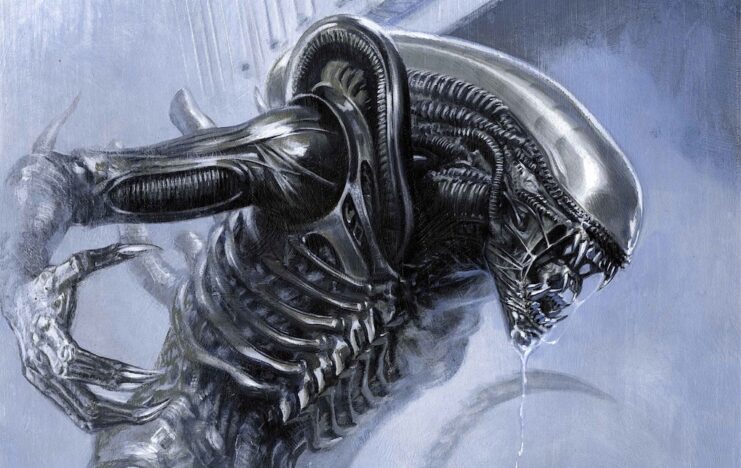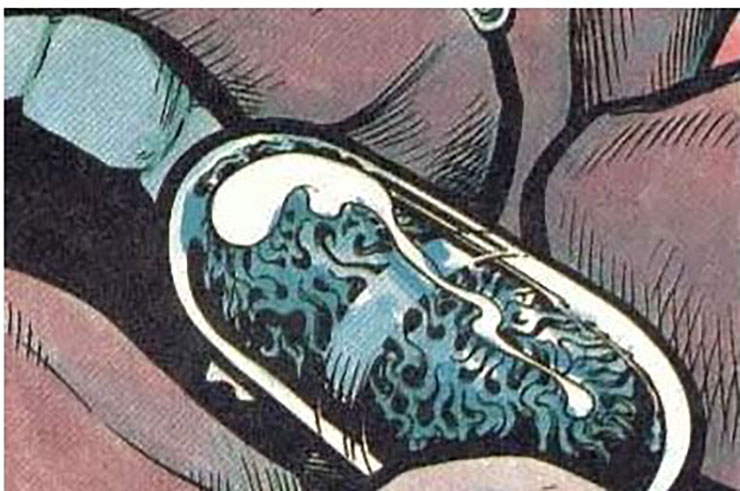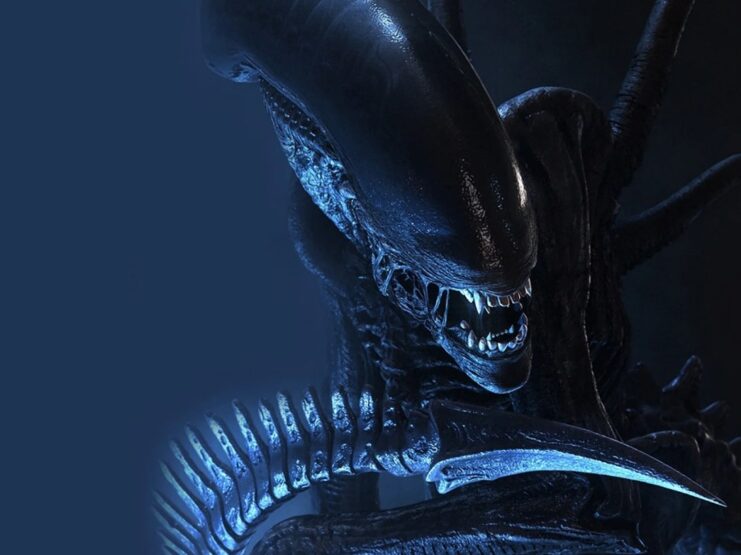Marvel now has the rights to publish Alien and Predator comics. As we prepare for those extra-terrestrial hardcases to take on the Avengers, David Black looks back at the mixed history of the Alien comics franchise.
In 1988, two years after James Cameron’s Aliens hit cinemas, the first original comic based on the property was published. Later entitled Outbreak, it picks up a decade after the second film and is an unashamedly direct sequel. One character gets us caught up: “It’s not like the Acheron mission was a success. Hell, the only survivors were a kid, a civilian named Ripley and Hicks…the kid’s a brain case and Ripley…well you know what became of her.”
After all, she’s been through, it’s perhaps unsurprising to see that Newt is in a mental hospital and Hicks has been drunk and disorderly. Hicks saves Newt and smuggles her aboard a spaceship bound for the Xenomorph homeworld, Newt falls in love on the way with a colonial marine with a secret.
They encounter a living ‘space jockey’ from the first film. Meanwhile on Earth, a cult has been worshipping the Aliens and the Bionational corporation has been studying the Alien. Inevitably the creatures escape and overrun the planet. Hicks, Newt and the Space Jockey return to Earth, but their extra-terrestrial friend came not to help humanity, but to conquer it.
Outbreak features a tight script with just the right tone and level of cynicism. During the fall of Earth, one character describes human civilization as “a pathetic charade of manners, predicated on a tissue-thin veil of lies.” The artwork picks up on the film aesthetic, but with a welcome sense of claustrophobia throughout. The miniseries was phenomenally successful and went through no less than six reprintings. The future of Aliens comics was assured.
The outbreak also set the pattern for future stories: the cold, indifferent greed of an evil corporate entity that was often Weyland Yutani in all but name, continued experimentation on the Xenomorph species and the dangers of unrestricted scientific ambition. The androids among us, are sometimes hidden in our midst, sometimes not. Those in power abuse it, go insane and assume they can control the Alien horde, despite all the evidence to the contrary. Then there is a struggle for survival as all hell breaks loose.

The sequel, Nightmare Asylum, sees the military attempting to train the Xenomorphs as troops to reclaim the Earth. Predictably, it does not go well. The story reintroduces Ripley, and the third in the trilogy shows us where she’s been all this time. Another mission with another group of marines. Now she’s back and she plans to rid Earth of invasive species. But she doesn’t. And nor does anyone else. Despite the obvious story potential, Earth is, perhaps inexcusably, purged of the Alien menace unseen between panels.

However, the Aliens comics take an interesting turn as Genocide gives us XenoZip, a steroid-like drug derived from the Xenomorph physiognomy and ‘royal jelly’. This aspect of Alien biochemistry dominates the strip for a couple of years and sees it explore aspects of addiction, smuggling and the physiological changes that it caused in its users.
Genocide also features the line “Leave the egghead work to me and my staff. You just provide the guns, the grunts and the gondola”, and, possibly uniquely, rather than getting his comeuppance and being killed, the arrogant soul that said this lives and learns from his experience, but the stories most important contribution to the Aliens comics line is the extraordinary moment of a Xenomorph getting hit full in the face by a saxophone and then attempting to play it.
These stories often explore previously unseen biological and sociological aspects of the Alien species. Over time, the subtext of many of them is that the Xenomorph are really the victims of these tales. Human greed is the real villain. As one character in Rogue says, “It’s a unique indictment of the human condition – we don’t just conquer our fears, we market them.” Several stories feature themes of religious faith, from a Xenomorph worshipping cult to a recitation of the Lord’s Prayer by huddled terrified stowaways waiting to be killed. The Xenomorphs are compared to the wrath of God itself.
By 1992, Dark Horse had carved out a thriving Alien universe and the release of Alien3 should have been causing for celebration, but instead, the film, spoiler alert, killed off Hicks, Newt and Ripley.
While the comics hadn’t been relying on them for a while, Dark Horse still wanted the comics to remain in continuity with the films and so reprints of the original trilogy of stories omitted flashbacks to the second film and changed names: Hicks, Newt and Acheron became Wilks, Billie and Rim respectively, while Ripley’s continued existence is entirely unexplained in the comics, a novelization reveals that this version of her is now an android.
Novelizations of comic strips were not the norm then and nor are they now. The first nine Aliens novels were all novelizations of comic miniseries. This shows a desire to elevate these stories to literature. These tales weren’t throwaway, they were worthy of being retold as prose.
The strip introduced its own recurring characters, such as the sinister genetic research scientist turned cult leader Professor Ernst Kleist, the cartoony self-proclaimed ‘professional bug killer’ mercenary Herk Mondo and the enigmatic Doctor Tellurian, but none eclipsed the trio from the films. This lack of a central character was an obvious obstacle to several of the writers and they sought to solve that problem by putting the Xenomorph center stage.
The comic strip had a lot going for it. HR Giger’s original Alien design has so far proved essentially artist-proof. Writers, artists and readers alike clearly had enormous enthusiasm for it. Those working on the comic felt confident enough to push the envelope. We had a story that features no aliens, followed by another that may only feature them as hallucinations, a story set in 50s America, a story devoted to the quality of the sound they make, a story drawing parallels between Colonial Marines and Viking Warriors and a comedy short about the eggs.
The Aliens comics were at their best trying to innovate. Too many stories focussed on the Xenomorphs at the expense of the human characters. Too many stories feature Xenomorphs in brightly lit environments and forego any sense of horror as a result. The best Aliens comics do neither of these.
In 1999, Xenogenesis arrived. It was a crossover event that formed a large story told across the Aliens, Predator and Aliens Versus Predator comics. Xenogenesis kicked against everything the Aliens comic strip did successfully. It featured superhero-style artwork and writing that introduced a vast array of awful characters, including an immortal caveman who survives a Xenomorph bursting through his ribcage.
The Aliens had become passengers in their own strip. Xenogenesis was intended to reinvigorate the Aliens, Predator and Aliens Versus Predator comic lines, but had the opposite effect and saw all three put on hiatus for the better part of a decade.
Ten years later, More Than Human was published and was a triumphant return to form. It took a back-to-basics approach taken from the first film. The characters are more three-dimensional and the Xenomorphs are largely lurking in the shadows. It is a technique that has served the comic very well ever since. The most recent wave of comics has addressed issues of post-traumatic stress disorder, claustrophobia and survivor guilt. The Aliens comics were back and so was the psychological horror.
After the success of the computer game, Alien Isolation, the Aliens comics began to include Ellen Ripley’s daughter, Amanda. The comics now alternate between the exploits of Amanda, Zula Hendricks and, their synthetic friend, Davis. And more isolated pockets of humanity encountering the Xenomorph for the first time. The Aliens comics that began with stories that wanted to relive the thrill of the second film, now concentrated on putting its characters through the horror of the original.
So where next? Well. if the teaser art is anything to go by, Marvel are going to pit the xenomorphs against Earth’s Mightiest Heroes. Will this be out-of-continuity or fit Giger’s monsters into Marvel’s superhero timeline? Expect new titles in 2021.

The highly detailed and hand-painted model, cast in specially formulated metallic resin, shows the third stage of the xenomorph life cycle. The chestburster is the serpentine alien implanted into host lifeforms by facehuggers. Despite their relatively small size, chest bursters always emerge in violent, fatal fashion. Once outside the host, they mature quickly, shedding skin as they develop into their deadly adult form.

